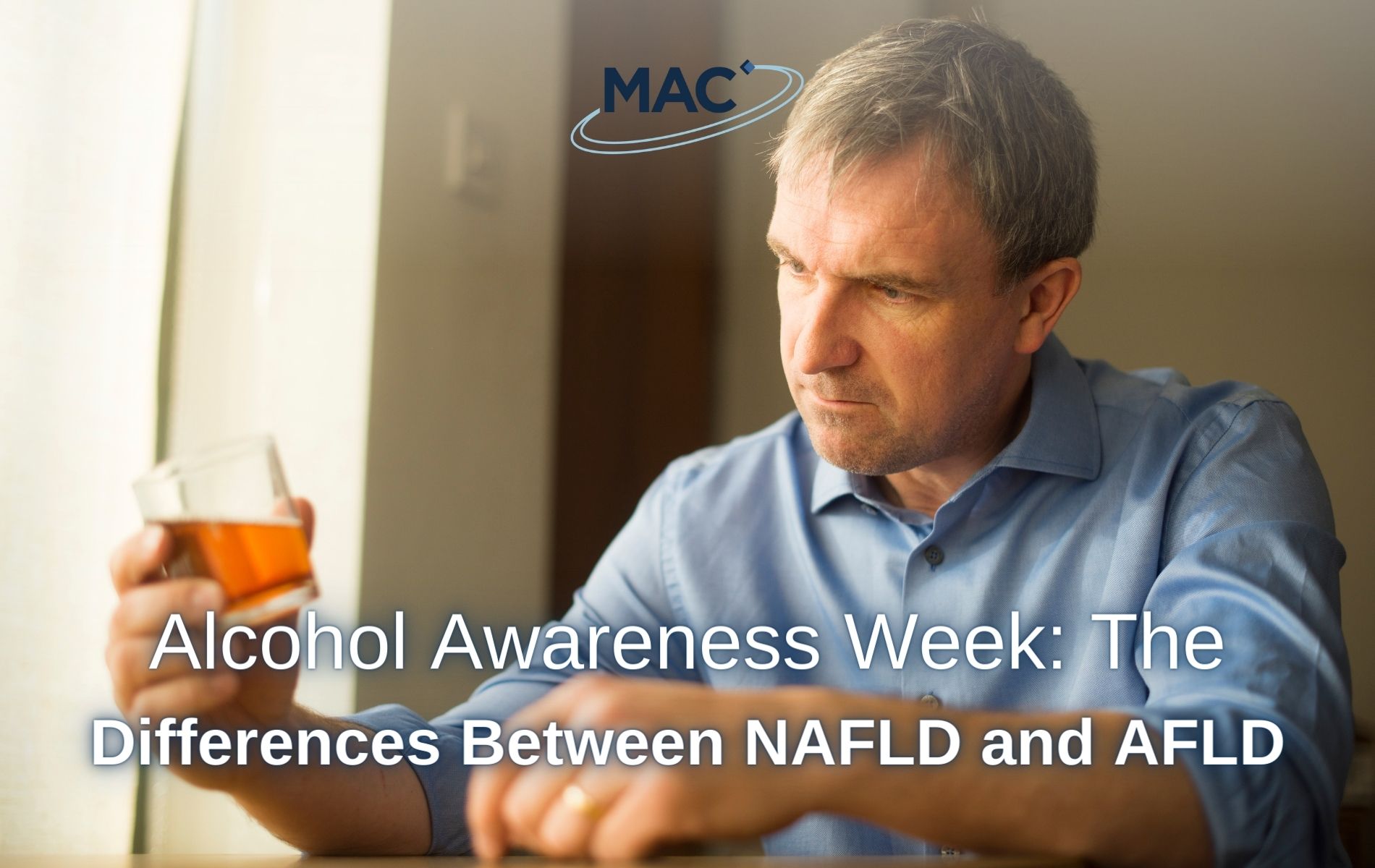Alcohol Awareness Week is an important time to highlight various liver diseases, including Non-Alcoholic Fatty Liver Disease (NAFLD) and Alcoholic Fatty Liver Disease (AFLD). These conditions share similarities in their impact on liver health but differ significantly in their causes, risk factors, and management strategies. Understanding these differences is crucial for effective prevention and treatment.
Causes and Risk Factors of Fatty Liver Disease
NAFLD is characterised by the accumulation of excess fat in the liver of individuals who consume little to no alcohol. This condition is primarily driven by metabolic syndrome, which includes things such as obesity and type 2 diabetes.
Genetics, poor diet, and sedentary lifestyle are significant contributors to NAFLD. Other risk factors include rapid weight loss, certain medications, and exposure to toxins. The British Liver Trust estimate that NAFLD impacts 1 in 5 people in the UK1.
AFLD, in contrast, results directly from chronic and excessive alcohol consumption. Alcohol metabolism in the liver produces harmful substances that can damage liver cells, leading to fat accumulation. Alcohol consumption is the most common cause of liver disease in the UK, accounting for 6 in 10 cases of liver disease2.
The risk of AFLD increases with the quantity and duration of alcohol intake. Genetics also play a role, with some individuals being more susceptible to alcohol-related liver damage. Additional risk factors for AFLD include poor nutrition and concurrent liver conditions such as hepatitis C.
Symptoms and Diagnosis of Fatty Liver Disease
Both conditions can have little to no symptoms in the early stages, making early diagnosis challenging.
In 2023 alone, 30,000 emergency admissions were caused by chronic liver disease in England, 13,000 were patients diagnosed for the first time upon admission3.
Common symptoms, when they occur, include fatigue, weakness, unexpected weight loss, and discomfort in the upper right abdomen. In advanced stages, signs of liver dysfunction such as jaundice, swelling in the legs and abdomen, and confusion may appear.
Diagnosis typically involves a combination of medical history, physical examination, blood tests, imaging studies (such as ultrasound, CT scan, or MRI), and sometimes liver biopsy. In NAFLD, the key is identifying fat accumulation in the liver without significant alcohol consumption. For AFLD, a history of heavy alcohol use is proscriptive for diagnosis.
Prevention of Fatty Liver Disease
Preventing NAFLD involves eating a healthy, balanced diet, regular physical activity, controlling metabolic conditions like diabetes and high cholesterol and where necessary losing weight. Regular medical check-ups and liver health monitoring are also important.
Preventing AFLD is more straightforward: limit alcohol consumption according to health guidelines. The NHS recommend avoiding drinking more than 14 units of alcohol a week for both men and women, spread across 3 days or more. That’s around 6 medium (175ml) glasses of wine, or 6 pints of 4% beer4.
For individuals struggling with alcohol use, seeking support from healthcare providers, counselling, and support groups can also be very helpful in reducing or stopping alcohol intake.
Treatment and Management of Fatty Liver Disease
AFLD treatment begins with complete abstinence from alcohol to prevent further liver damage.
Managing NAFLD, on the other hand, focuses on lifestyle modifications to address underlying metabolic risk factors. This might include weight loss through diet and exercise and managing diabetes and cholesterol levels. If NAFLD progresses, it can become Non-Alcoholic Steatohepatitis (NASH), a more severe form of the condition.
There are currently no treatments approved in the UK for NASH, and further research is needed to help those living with the condition.
MAC are looking for people to take part in a new clinical trial, investigating a new potential treatment for NASH.
NAFLD and NASH can be hard to diagnose because they often have few or no symptoms, and symptoms can sometimes be misdiagnosed. You don’t need a NASH diagnosis to apply for this study. If you meet certain criteria, you may qualify for a free liver check as part of the eligibility process. You may be eligible if you have a NASH diagnosis or are overweight and have risk factors such as type 2 diabetes, high blood pressure, high cholesterol, or high triglyceride levels.
If eligible, you may receive up to £2,490 and all study related assessments and medications will be provided free of charge.
For more information, visit MAC Clinical Research’s NASH research page.
1 British Liver Trust – MASLD, NAFLD and fatty liver disease
2 British Liver Trust – Alcohol-related liver disease (ARLD)
3 British Liver Trust – New research reveals late detection of liver disease crisis with more than a third dying within a year of diagnosis
4 NHS Better Health – Drink less




